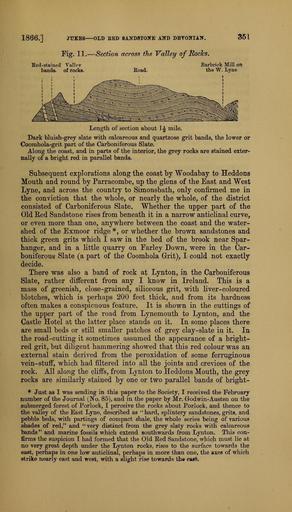MAKE A MEME
View Large Image

| View Original: | The_Quarterly_journal_of_the_Geological_Society_of_London_(13935509061).jpg (1170x2049) | |||
| Download: | Original | Medium | Small | Thumb |
| Courtesy of: | commons.wikimedia.org | More Like This | ||
| Keywords: The Quarterly journal of the Geological Society of London (13935509061).jpg 1866 <br> JUKES OLD KED SAITDSTOXE AlfD DBTOIflAIf <br> 361 <br> Fig 11 Section across the Valley of Rocks <br> Eed-stained Valley <br> bands of rocks <br> Eoad <br> Barbrick Mill ott <br> theW Lyne <br> Length of section about 1- mile <br> Dark bluish-grey slate with calcareous and quartzose grit bands the lower or <br> Coomhola-grit part of the Carboniferous Slate <br> Along the coast and in parts of the interior the grey rocks are stained exter- <br> nally of a bright red in parallel bands <br> Subsequent explorations along the coast by Woodabay to Heddons <br> Mouth and round by Parracombe up the glens of the East and West <br> Lyne and across the country to Simonsbath only confirmed me in <br> the conviction that the whole or nearly the whole of the district <br> consisted of Carboniferous Slate Whether the upper part of the <br> Old Eed Sandstone rises from beneath it in a narrow antichnal curve <br> or even more than one anywhere between the coast and the water- <br> shed of the Exmoor ridge or whether the brown sandstones and <br> thick green grits which I saw in the bed of the brook near Spar- <br> hanger and in a little quarry on Farley Down were in the Car- <br> boniferous Slate a part of the Coomhola Grit I could not exactly <br> decide <br> There was also a band of rock at Lynton in the Carboniferous <br> Slate rather different from any I know in Ireland This is a <br> mass of greenish close-grained siliceous grit with liver-coloured <br> blotches which is perhaps 200 feet thick and from its hardness <br> often makes a conspicuous feature It is shown in the cuttings of <br> the upper part of the road from Lynemouth to Lynton and the <br> Castle Hotel at the latter place stands on it In some places there <br> are small beds or still smaller patches of grey clay-slate in it In <br> the road-cutting it sometimes assumed the appearance of a bright- <br> red grit but diligent hammering showed that this red colour was an <br> external stain derived from the peroxidation of some ferruginous <br> vein- stuff which had filtered into all the joints and crevices of the <br> rock All along the chifs from Lynton to Heddons Mouth the grey <br> rocks are similarly stained by one or two parallel bands of bright- <br> Just as I was sending in this paper to the Society I received the February <br> number of the Journal No 85 and in the paper by Mr Grodwin- Austen on the <br> submerged forest of Porlock I perceive the rocks about Porlock and thence to <br> the valley of the East Lyne described as -'hard splintery sandstones grits and <br> pebble beds with partings of compact shale the whole series being of various <br> shades of red and very distinct from the grey slaty rocks with calcareous <br> bands and marine fossils which extend southwards from Lynton This con- <br> firms the suspicion I had formed that the Old Eed Sandstone which must lie at <br> no very great depth under the Lynton rocks rises to the surface towards the <br> east perhaps in one low anticlinal perhaps in more than one the axes of which <br> strike nearly east and west with a slight rise towards the east 36164792 111477 51125 Page 351 Text v 22 http //www biodiversitylibrary org/page/36164792 1866 Geological Society of London Biodiversity Heritage Library The Quarterly journal of the Geological Society of London v 22 1866 Geology Periodicals Smithsonian Libraries bhl page 36164792 dc identifier http //biodiversitylibrary org/page/36164792 smithsonian libraries Information field Flickr posted date ISOdate 2014-04-21 Check categories 2015 August 26 CC-BY-2 0 BioDivLibrary https //flickr com/photos/61021753 N02/13935509061 2015-08-26 06 56 56 cc-by-2 0 PD-old-70-1923 The Quarterly journal of the Geological Society of London 1866 Photos uploaded from Flickr by FĂŚ using a script | ||||